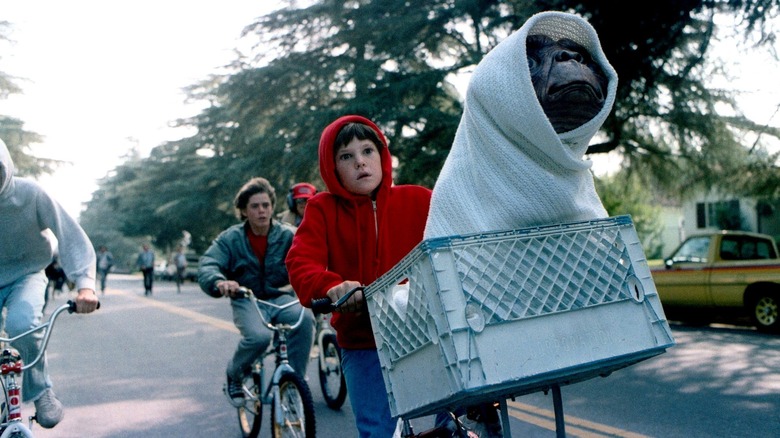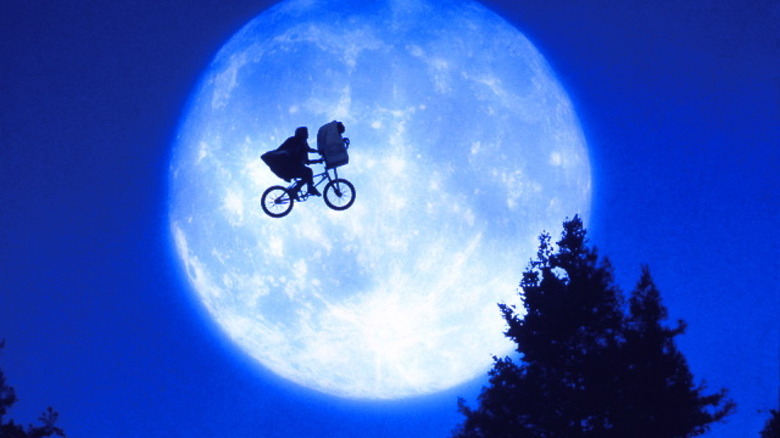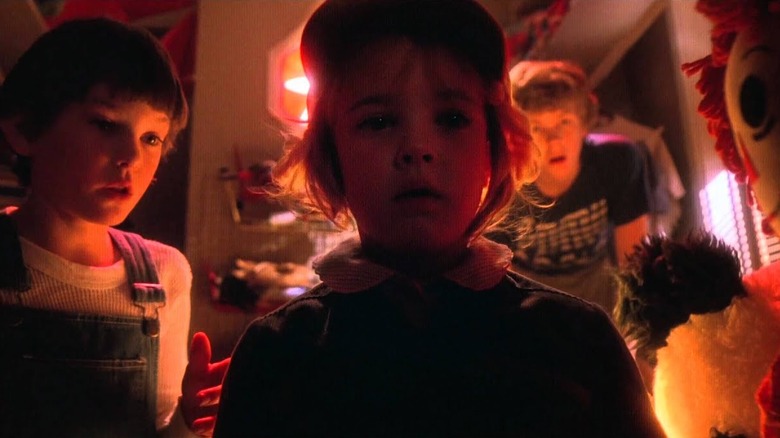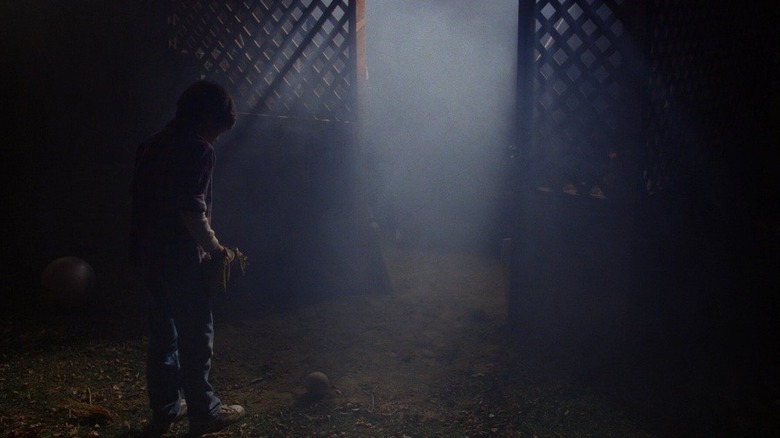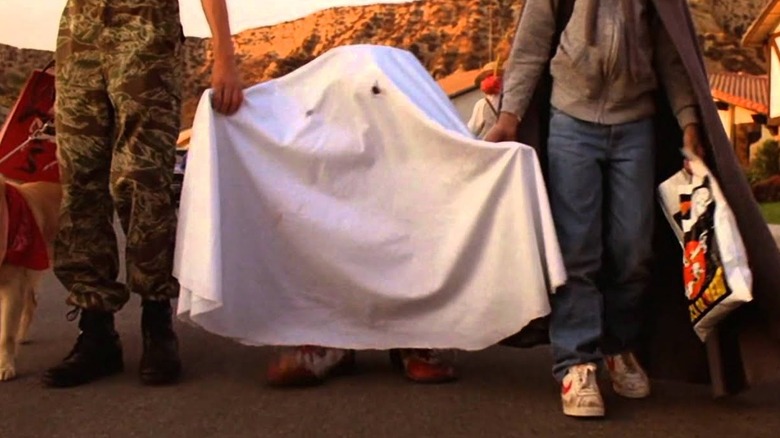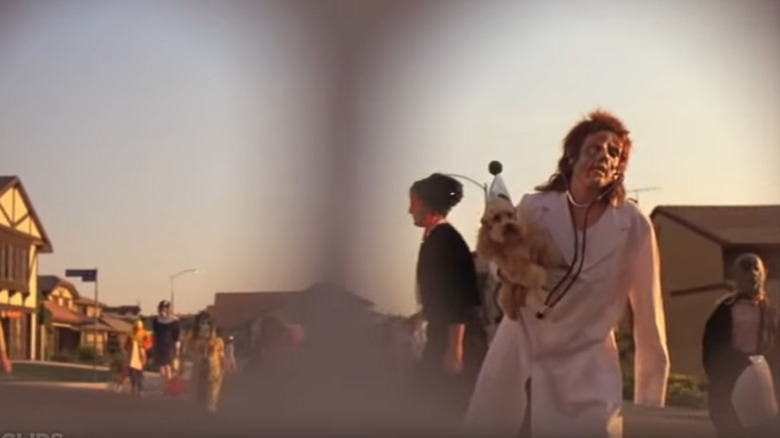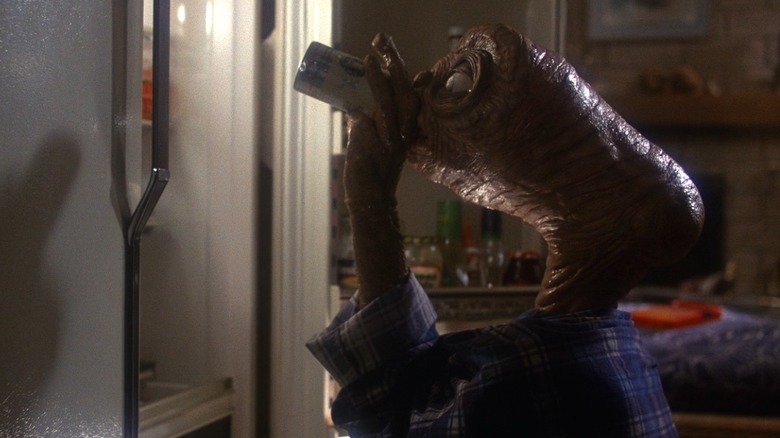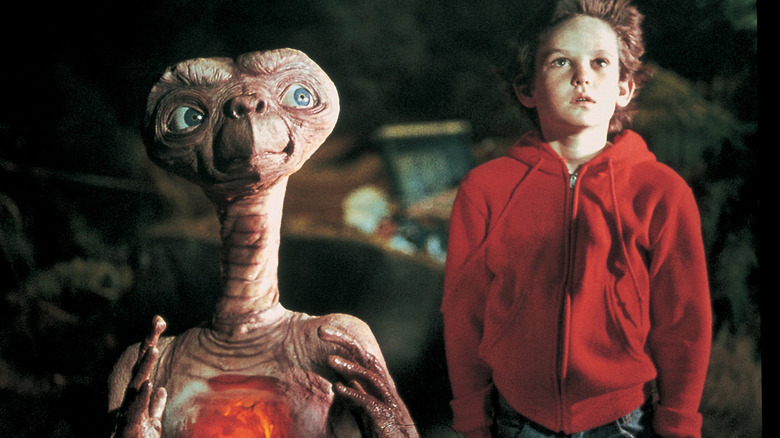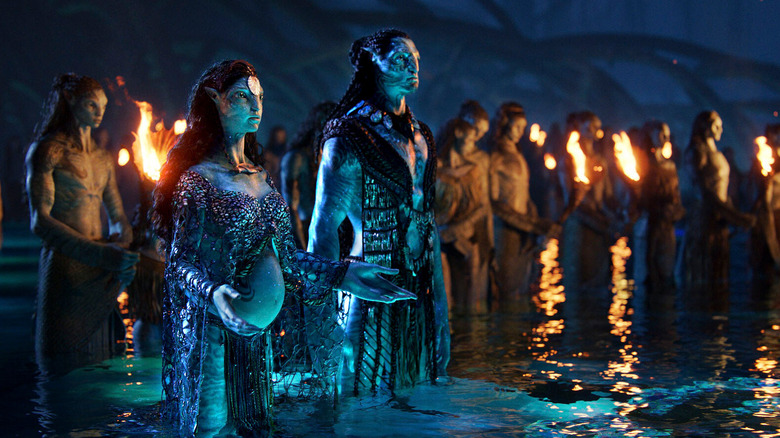E.T.'s Oscar-Winning Costume Designer Reflects On That Halloween Scene And Creating A Timeless Classic [Exclusive Interview]
For a director whose body of work contains some of the most instantly recognizable images in all of cinema, Steven Spielberg's 1982 masterpiece "E.T. The Extra-Terrestrial" is arguably his most visually rich movie. The mixture of cinematographer Allen Daviau's expressive color palette and the cast's open-hearted faith in a creature that was ultimately a hunk of wires and rubber helped make the film a slice of pure movie magic.
One of the collaborators that deserves a large amount of credit for bringing "E.T." to life is Academy Award-winning costume designer Deborah Lynn Scott. Her work on the film ensured that not only would the look of the titular alien enter the popular culture, but that the human characters of the film would be just as memorable. Her penchant for iconography began with "E.T.," and has continued in her subsequent work designing costumes for "Back to the Future," "Heat," "Titanic," the "Transformers" movies, and both "Avatar" and its upcoming sequel, "Avatar: The Way of Water."
I had the opportunity to speak with Scott given the occasion of "E.T." being released on disc and digital formats in a brand-new 40th anniversary edition. We discussed how the making of "E.T." was as joyous as the movie itself, how it managed to capture the spirit of the Halloween season, and how costume design is learning to adapt to the advent of digital characters in cinema.
'This is going to be a little movie'
Note: This interview has been lightly edited for clarity and brevity.
I wanted to say right off the bat that E.T. is a perennial of mine. We share a birth year! I had this little squashy E.T. doll in my crib with the leather that cracked open later. So because I've literally lived my entire life with E.T. in it, I was curious to know about how E.T. came into your life. How did it start?
Well, it was absolutely the kind of highlight. It's one of my very first films. And just before that, I had completed a film with Carol Ballard called "Never Cry Wolf." Carol Ballard is part of that San Francisco group of directors, so it gave me a little street cred, I think. And I knew a few people. I knew Kathy Kennedy very vaguely, so I was very lucky, out of the blue — and I don't actually remember how — but I got called in to interview with Steven. He'd already done such amazing [movies like] "Jaws," he'd done so many movies, it was kind of like, "Well, this is going to be a little movie." It was very, very low key.
So he just hired me right off the bat. We had a really wonderful talk, and we talked a lot about the movie. It's so simple at heart, and Melissa Mathison, the screenwriter, is just one of the genius screenwriters, and it was a shame to lose her so young. But it's such a beautiful script. When she writes something, you just read it and you can feel it and see it. So it was quite easy to connect through that, the words on the page.
'It was a very intimate filmmaking experience'
I think this was before the casting had started. Maybe they had Henry [Thomas, who plays Elliott], I'm not quite sure. But we just started to work on it. And a lot of us were in our 20s. We were quite young, just getting started. And for some reason, that's the way Steven wanted it. He could have had anybody in the business do any job, but there were a lot of first timers on the movie. I think it was Allen Daviau's first really big Hollywood movie. And unfortunately we've lost him, too. So there's a little bittersweetness with it. But it was absolutely the sweetest group of people, the sweetest experience to be in.
I went back and looked at some of the behind-the-scenes footage, and it was so like that. I mean, Steven was just absolutely lovely. It was a fairly small group of people. It was a very intimate filmmaking experience, especially once you bring children into it. It was just always quiet and lovely and amazing on the set, aside from the fact that we had just groundbreaking technology in use with establishing and making this creature who became a beloved little E.T., a beloved little guy around the world. So it's amazing and not surprising that it's lasted because it's just a genuine film.
'It's like looking at a Norman Rockwell'
I agree 100%. I'm interested to know — and this ties in with my interest in your general philosophy of costuming — using E.T. as an example, do you attempt to reconcile all the elements that are there in terms of story, theme, and genre? Or do you go from a character-first perspective? What is your general approach?
I think we have that kind of overall arcing sense of all the elements that the film could be. But again, at its heart, it's such a beautiful story that reaches across generations and really touches the hearts of mothers and children and things like that. So I think the concentration was really on not only building the characters one by one, but establishing that little family unit that they had and the wonder of welcoming this extraterrestrial creature into their midst.
And you'll notice — I'm sure Steven's talked about this behind the scenes many times — how there aren't really very many grownups in the movie. You don't see them. You don't see their faces. You're attached to the mother, of course, but it's this kind of interior exterior movie with these children, with Henry at the center. And they're all amazing little actors, but Henry's really one of the sweetest little boys I've ever been around. And mind you, I didn't have kids, I was quite young myself. But the intimate experience, dealing with all of them and with Steven and everyone being so hands on and very involved in the process.
I think Steven and I talked early on about, [the film] is a little bit nostalgic, but more than that, it's almost like you're creating a world that was timeless. It's like looking at a Norman Rockwell. That was kind of the touch point. Everything lasts. There's nothing in there in terms of the clothing that's too weird or too out there or too dated. It just holds its own in a very, very character-driven way.
'No one knows where she disappeared to on that night'
I like to champion E.T. as a low-key Halloween movie, because it is set around there. It really does capture the spirit of the holiday and that kind of childhood magic of Halloween. Could you talk about figuring out the costumes for the characters in that sequence? How did Gertie and E.T. become a ghost at the same time, and the mom in the cat costume?
The ghost was pretty easy. In fact, it might have been in the script, right? Because you needed something that could cover the entire being of E.T. so that he wasn't exposed. And at the same time, you could cover Gertie so that the mother and other people could be confused as to what was under that white sheet. And again, a ghost in a sheet [has been] a classic child's Halloween costume for decades and decades and decades. So it sort of speaks to nothing too current or weird. Very, very traditional in a sense. And I think from there, we just expanded.
I think in the script, too, Gertie says she wants to be a cowgirl. That's what she really wants to be. And that was near and dear to my heart because when I was a child, that was modeled off of a costume that my mother had made for me. And then the boys getting into those ghoulie, whatever, monster-y [costumes]. [laughs] And they're very, very homemade. They're not store bought, and [that] expanded into the world of the kids on the street, which is one of the most magical shots of the movie, really, where you see all these creatures and all those little nods and winks to other movies. And him passing Yoda, which is just brilliant.
I can't remember exactly Mary's cat thing. I think it was an extension more of her personality — how she's this very divorced mom, lots of stuff going on, trying to raise these children pretty much alone. And I think it was her moment to kick out of that and be like, "Look at me, I can be cute and sexy and all that at the same time." And the boys, I remember them just kind of looking at her like, "Huh? Mom?" And no one knows where she disappeared to on that night. Pretty hard to say. We never really follow up.
But there's also an element in the Halloween part and in the whole movie where children have the capability of noticing when their parent isn't watching and going into their own little imaginary, or in their case, real world, which is really, really wonderful.
'Let's put Debra in a costume'
I have to ask you, so you can confirm or deny or not answer, but is that Debra Winger in the Zombie Doctor costume?
Oh yeah. She's in there. She was visiting that night. It wasn't a very big budget movie, so we had to call on extras to come in and all the kids and sort of [hoped] they looked good. And we had some costumes, but Debra came to visit that night. And I didn't know at that time that she was kind of E.T.'s voice for a while, right? So it made sense. Steven's like, "Let's put Debra in a costume," and I was like, "Oh my God." So we scrambled, and we pulled something together. It was pretty fun.
'There are a lot of very sentimental things in that movie for me'
One of my favorite scenes in the movie is when E.T. gets drunk, and one of the elements that brings that scene to life for me is that robe he's wearing. What's your thought process in terms of dressing a non-human fantasy character?
I think it just depends on their character and the circumstances that they're in at the moment. And E.T. clearly was trapped inside that house. I guess he could have left if he had really gotten it together, but he only had what he had to work with. So the thought was that he took this bathrobe, and I think that came from Steven, too. He was just going to be this drunk guy on the couch. And that bathrobe, it actually had belonged to my father. So there are a lot of very sentimental things in that movie for me. And I think because of the heart of it, that's why it sometimes touches others.
'That little red hoodie, it stood out'
So your career is obviously enormous. You've done so much that's impacted my life and the lives of others. I was wondering in terms of all this iconography that's in your career — from E.T. to Elliott's hoodie, Marty McFly, "The Amazing Spider-Man 2," which is the best Spider-Man costume —
Thank you. I thought so, too. We went back to basics. It was totally the basics. We went back to the classic, basic, "That's what Spider-Man was, and that's what he should be."
Are you chasing iconography and trying to find an iconic element of each character to bring out? Or is it just happenstance that it comes out that way?
I think it's mostly happenstance. The ability to really tune into the moment and the character, that's where you get the opportunity later on to establish that. It sort of comes as part of the vernacular of the film, the collective unconscious, if you will. And that little red hoodie, it stood out, right? I know my daughter's gone to screenings of the movie at the Hollywood Forever Cemetery and people are wearing red hoodies. So it's very gratifying. It's really, really nice when that happens.
I think honestly, for me, one of my favorite costumes in the movie is when Henry first goes out into the backyard, and he's got his little thermals on and his little down coat and his socks. All those things, I tried to choose — again, keeping with this Norman Rockwell, very common, right in the pocket of Americana — items that could be across generations of people. Thermal underwear, they've been around for decades and decades. So things like that, to choose these things very purposefully. They weren't too fashion-oriented or specific to a generation. And you can see that, the little overalls, things like that, cross decades of generations. So I think that's one of the things that keeps it just very focused and on track.
'Talk about a whole new world'
I know you probably can't talk much about "Avatar: The Way of Water" as it's coming out soon, but I'm so fascinated that you started in this era that was very tangible and old school as it had been for decades. And now we're moving into a more digital space in Hollywood. Do you find that your job is changing at all in that way? Or do you think it's still the same?
Yeah, I think that's a very good question. Interestingly on E.T., it was one of the first times that blue screen was used. It was very new at ILM. We traveled to ILM to do those effects because there was no place else to really do it, and the restrictions of how you could use blue screen were very severe. You'll notice in that scene, the color range is so monochromatic. Even the denim had to be really dyed down because denim was too close to blue.
And now that kind of thing is almost like, it doesn't really matter. Anything can go in front of a blue screen or a green screen, as long as it's not exactly the color which, who would put that on anyone, anyway? But I think the concept, the genesis, the heart of costume design has stayed exactly the same.
It should be the same, because what you're doing is, no matter what your technology that you have available, which on something like "Avatar: The Way of Water" is massive, right? Talk about a whole new world, that we're not particularly educated to do. So there's a lot about filmmaking where you jump into a project and you're like, "Wait, what?" You have to learn as you go along. So there's always something new. There's always something challenging in those kind of technical ways. How do you make Spider-Man fly? How do you do these kinds of suits? Things like that. So there are a lot of people working that use a lot of resources.
But I learned a tremendous amount technically on "Avatar: The Way of Water." But I was absolutely in my roots, in my wheelhouse, to just look at these characters as people, and the characters that they are, the people that they are, what the circumstances around them [are], how it unfolds, and dress them accordingly.
So in the "Avatar" movies, obviously it's a fantasy, but it's very grounded in reality about, what do a clan of people look like? Act like? How their society is. So all those things still come into effect. What's the weather like? Is it hot? Is it cold? All those things come into effect when you design costumes. So the kernel of it is exactly the same. The things at your fingertips or the questions you have to answer could be completely different.
Sounds fantastic. I'm so excited to see it and see what you've done.
I hope you love it. I think it's going to be actually a visual wonder.
"E.T. The Extra-Terrestrial" is now available in a 40th Anniversary edition on 4K Ultra HD, Blu-Ray, and Digital.
